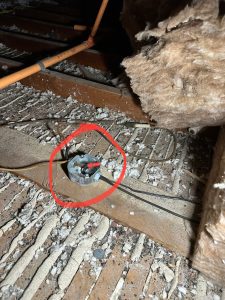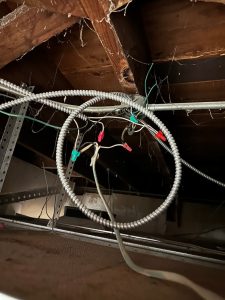Knob and Tube Wiring Replacement Services
What is Knob and Tube Wiring?
Knob and tube wiring is a kind of electrical system that was commonly used in America from about 1880 to the 1950s. It doesn’t pose a grave danger but can be a safety hazard. It is dangerous because of its age and improper modifications. Knob and tube wiring is not illegal but it is prohibited in new construction nowadays.
How do I know if my home has it?
Knob and tube is not difficult to identify. The easiest way to check for knob and tube wiring is to look in your basement and attic for little white tubes made of porcelain with wires running through them. If you don’t find knob and tube wiring in your house, it doesn’t always mean that you don’t have it. It could be hiding in the walls. We recommend to call a professional to open the walls if you are not sure that your house has knob and tube wiring.

Problems With Knob and Tube Wiring:
1. Fire Hazard
Old knob and tube wiring can be a safety hazard. Because it is made of rubber and cloth, in many cases heat and air exposure causes the rubber to become brittle and the damaged insulation does not protect the wire and your home becomes hire hazard.
2. Modifications
Asphalt-soaked cotton sheaths or rubber breaks down over time. This allows wires to be exposed and raises the risk for electrical shocks and burning even during renovation.
3. No grounding conductor
It does not have a grounding conductor. These conductors decrease the chance of electrical fire and damage to your equipment.
When knob and tube wiring was installed, there weren’t a lot of electrical appliances in houses.
Nowadays it is impossible to imagine a house without TVs, washers, dryers, computers, EV chargers and other appliances. Too many extension cords can be really dangerous for your old wiring.
Why Upgrading Knob-and-Tube Wiring Matters – Expert Insights for San Francisco Homes
Visual Identification of Knob and Tube Wiring
To help you better understand the appearance and typical issues associated with knob and tube wiring, we have included a gallery of images below. These pictures highlight the distinctive elements of this vintage wiring method, showing the porcelain knobs and tubes that contain and protect the wires.






Photos Include:
Homeowners may use these pictures as a warning and reference to identify any hazards in their own electrical systems. We advise getting in touch with an expert for a comprehensive assessment and any required modifications if you think your house could contain knob and tube wiring; these images will help you recognize comparable elements.
What Should I Do If My Home Has Knob and Tube Wiring?
If your house has knob and tube wiring, you don’t always have to replace it. But if you want or need to make an electrical upgrade, you should hire a licensed and experienced electrician.
Even though knob and tube wiring doesn’t pose a serious danger you should remember that it can be fire hazard!
- 88 Garnett Terr, San Francisco, CA, 94124
- 777 South Mathilda Ave. Sunnyvale, CA, 94087
- 1611 Elm St, El Cerrito, CA, 94530
- 1112 Mission Ave, San Rafael, CA, 94901
- +1 (415) 867 7006
- +1 (650) 772 9701
- maxelectric.sf@gmail.com
- Our Yelp reviews
Our Knob-and-Tube Wiring Replacement Process
At Max Electric, we ensure a seamless and safe replacement process tailored to your home’s unique needs.

Comprehensive Inspection
We begin by thoroughly inspecting your home’s electrical system to locate and evaluate existing knob-and-tube wiring.

Customized Plan
Our team designs a replacement plan that minimizes disruption to your home’s structure while ensuring complete code compliance.

Professional Installation
Using the latest techniques, we replace your wiring with modern alternatives like Romex cables, ensuring durability and safety.

Post-Installation Testing
Once the replacement is complete, we conduct rigorous testing to ensure the new system operates safely and efficiently.
